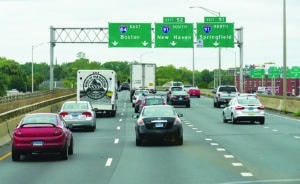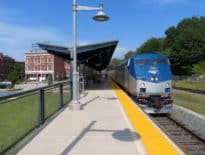Greater Boston’s traffic-clogged highways and chronically jam-packed and reliably unreliable subway and commuter rail trains have finally grabbed the attention of state leaders.
But as a potential multibillion-dollar overhaul of the region’s transportation system sparks debate at the State House, the cost of actually getting the job done could prove far higher than anyone has bargained for, new research suggests.
The Bay State’s duo of high median incomes and some of the highest home prices in the country could set the stage for some epic transportation project overruns.
A recent study by a pair of professors from Yale Law School and George Washington University found that the cost of building a single mile of highway, adjusted for inflation, tripled over the more than three-decade rollout across the United States of the federal interstate highway system.
And the main contributors that drove up those costs weren’t bigger paychecks for construction workers, or even the rising cost of steel, but rising incomes and rising home prices.
In fact, states that had the biggest increases in both pay and real estate also saw the biggest increases in the cost of highway construction, according to the report by Zachary Liscow, an associate professor at Yale Law School, and Leah Brooks, associate professor of public policy and public administration at George Washington University.
Adjusted for inflation, the cost of federal highway construction tripled by the time the rollout of the interstate system, which kicked off in the 1950s, was completed in the early 1990s, according to the study, submitted as part of a Brookings Institution conference.
The Federal Highway Administration estimated in 1956 it would take 13 years and $25 billion (or $192 billion in 2016 dollars) to build out the federal highway system. Instead, the job took 40 years and more than $504 billion to complete.
The Squeaky Wheel Gets the Overpass
It’s not that higher home prices lead to increased land-taking costs; rather, it’s that wealthier people with more expensive homes are far more demanding when highways or other big infrastructure projects are built, insisting on more of everything, including noise barriers, ramps and detours around particular neighborhoods.
And here in NIMBY Massachusetts, we know a thing or two about being demanding, now don’t we?
“All the same drivers that led to the increases in our paper continue today and are possibly stronger,” Brooks said.
The GWU professor points to the housing market, with the growing belief among economists that a big reason for the run-up in housing prices has to do with regulatory constraints placed on new construction, often at the behest of wealthy homeowners.
“I think a lot of the institutions that limited residential construction also impacted interstate highway construction,” she said.
Of course, affluent homeowners have always been with us. And while there may be more of them as both incomes and real estate prices have risen in Massachusetts and across the country, the increase alone isn’t enough to explain the big jump in highway construction costs.
Environmental Regulations Also Add to Costs
The second big contributor was the rise of the environmental movement in the late 1960s and 1970s, and the bevy of new laws and regulations designed, at least in theory, to give the average citizen a say over major new public works proposals and private developments.
And who exactly was best poised to take advantage of these environmental laws and regulations, designed, mind you, to give ear to the so-called “citizen’s voice?”
Your more affluent citizens and homeowners, of course, who, empowered as never before by the political, legal and regulatory system, were able to successfully demand changes in proposed highway projects.
(While it’s not covered by the study, it’s not hard to see how a parallel process took place in regards to proposals for new residential development, with suburban homeowners using a combination of local restrictions and newly minted state and federal environmental laws to block proposals for new apartment buildings and other, less expensive housing.)
“Increases in income led to political demands for more expensive highways, and changes in the legal and political regime led to those making the increased demands having more of a voice,” Liscow said.
As a result, federal highway projects built in the later years of the rollout of the interstate system featured more “ancillary structures” than those built in the first years.
Highways planned during the later stages also featured “more wiggly routes” detouring around various areas. From the 1970s on, environmental issues also became a major discussion point as highway projects were debated and planned, the study noted.
“Just building the sound walls alone could explain the increase,” Brooks said, adding “they are pretty expensive.”
The Cost of Endless Mitigation
The rise in highway construction costs varied from state to state, with the biggest increases coming in states like Massachusetts that saw the largest gains in incomes and home prices.
The study only goes up through the early 1990s, when the federal interstate highway system was largely complete.
But the factors that drove up highway costs in those decades – home prices and incomes – have veritably exploded since then in Massachusetts, and, in particular, in Greater Boston.
And there is no reason to think these same factors won’t exert strong upward pressure on costs as state leaders weigh a range of new transportation overhauls and projects, from new highway lanes to new train lines.
Recall that Brooks and Liscow saw a tripling in the cost to build one mile of federal highway over the 1970s and 1980s.
That’s a big, flashing red light as Gov. Charlie Baker and state legislative leaders debate plans for a multibillion-dollar overhaul of the state’s highways and train and subway lines.

Scott Van Voorhis
Here’s hoping we haven’t become so fat, happy and complacent in Greater Boston that we can’t rein in the wish lists and demands for endless mitigation and head off a public works cost catastrophe.
Scott Van Voorhis is Banker & Tradesman’s columnist; opinions expressed are his own. He may be reached at sbvanvoorhis@hotmail.com.







